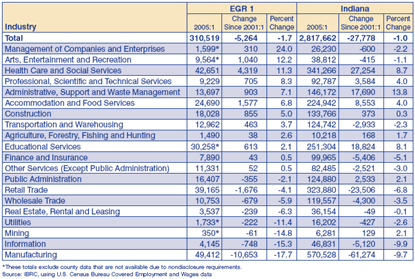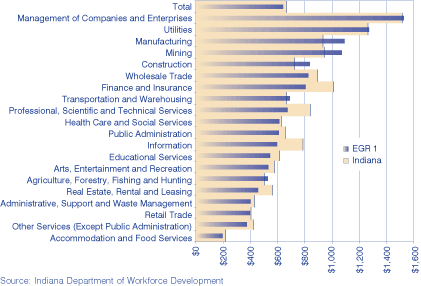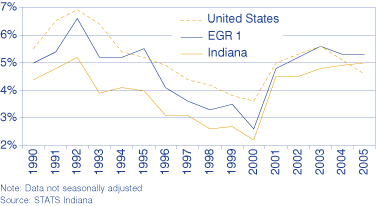Economic Growth Region 1: Northwest Indiana
The Indiana Department of Workforce Development recently defined 11 economic growth regions (EGRs) across Indiana. Region 1, located in northwest Indiana includes Jasper, Lake, La Porte, Newton, Porter, Pulaski and Starke counties. These seven counties constitute 13.8 percent of Indiana's total population with nearly 840,000 people (see Figure 1). Lake and Porter counties have contributed more than 88 percent of the growth in the EGR's population over the past year, while La Porte and Newton counties have been slowly declining in population since 2000.
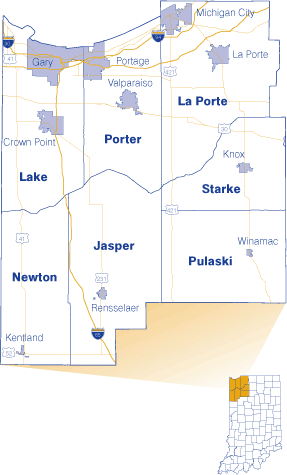
Figure 1: Population Distribution, 2004
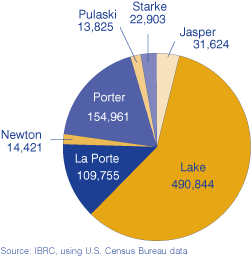
In contrast to the overall population gains in Lake County, three of its four largest cities declined from 2000 to 2004. Combined, Gary and Hammond, with populations of nearly 100,000 and 80,000, respectively, lost about 6,000 people during that time. Meanwhile, relatively smaller cities in the county and region were gaining in popularity: in EGR 1, 56.6 percent of growth occurred in cities with populations between 20,000 and 36,000.
Jobs
In the first quarter of 2005, there were 16,210 establishments supplying over 310,000 jobs in the seven-county region. Manufacturing and health care and social services had more than 40,000 employees each, but they were on opposite ends of the spectrum in terms of change in jobs from the first quarter of 2001. Retail trade came in at a close third in the region with more than 39,000 jobs. While the retail trade sector experienced a 4.1 percent decline from its 2001 level, it performed 2.7 percentage points better than Indiana's 6.8 percent decline.
Manufacturing had the highest number of jobs in the region but lost more than 10,000 jobs (a 17.7 percent decline) from the first quarter of 2001 to the first quarter of 2005. The health care industry made up 13.7 percent of total jobs for the region as a result of the 4,319 jobs added during the same period (an 11.3 percent increase). With similar trends, Indiana experienced an 8.7 percent increase in health care and social services jobs and a decrease in the manufacturing industry by 9.7 percent. Table 1 shows which industries gained in both Indiana and the region and which ones lost jobs. Overall, the region encountered a drop of 5,264 jobs during the four-year period.
Table 1: Change in Jobs in EGR 1 Compared to Indiana*, 2001:1 to 2005:1
Wages and Income
An overall increase in wages in both the region and the state attempt to offset the large number of jobs lost. Region 1 has increased its wages from the first quarter of 2001 to the same quarter in 2005 by $53, or $10 more than the state for the same period. Weekly manufacturing wages increased by $196 in the region from the first quarter in 2001 to the first quarter of 2005, raising the average weekly wage for manufacturing in the seven-county region to $1,094. That amount is $160 more than Indiana's average weekly wage for the manufacturing industry, compared to a difference of only $68 four years prior.
The largest difference between average weekly wages for the region and the state was in the finance and insurance industry. Indiana's average weekly wage was $1,012 for the industry, while Region 1 only paid an average of $806 per week, a difference of $206 (see Figure 2).
Figure 2: EGR 1 Average Weekly Wage by Industry Sector, 2005:1
Housing
Region 1 accounted for 12.9 percent of Indiana's total housing units in 2004 (347,412 units). On a percentage basis, both Jasper and Porter counties added more housing than the state of Indiana from July 2000 to July 2004. Lake County constituted more than 49 percent of that change in housing units during the same period for the region. By 2004, Lake County had more than 200,000 units making up 58.4 percent of total housing units in the region.
From 1990 to 2004, EGR 1 contributed 15 percent of the overall growth in building permits issued across Indiana. Indiana issued 134 fewer permits in 2004 than it did in 2003. Meanwhile, the seven-county region remained steady in the number of building permits issued. All but Starke County had the majority of their permits for single-family units, with at least 80 percent of the permits issued. Both Newton and Pulaski counties had 100 percent of their permits issued for single-family units. Starke County, on the other hand, had 63.2 percent of its permits issued for five-or-more family units and only 31.6 percent allocated to single-family units.
Unemployment
The region has historically remained higher than, but in line with, the state in terms of the unemployment rate (see Figure 3). In October 2005, the region's unemployment rate stayed steady at 5.3 percent when compared to October 2004. This was higher than both the state and the nation by 0.3 percentage points and 0.7 percentage points, respectively.
Figure 3: Unemployment Rates, October of Each Year
Commuting
Nearly 250,000 residents (76.6 percent of the workforce) in EGR 1 work and reside in the same county. Meanwhile, the 68,000 EGR 1 residents that commute out of the region make up 18.6 percent of the labor force. Figure 4 shows the region's commuting patterns at the county level. Not surprisingly, 71.7 percent of commuters who travel out of the region travel to Cook County, Ill., home of Chicago.
Figure 4: EGR 1 Commuting Patterns

According to the latest data from the Bureau of Motor Vehicles, more drivers in EGR 1 are likely to drive a Chevrolet than any other type of vehicle. Of the nearly 440,000 vehicles registered in the region, 17.3 percent are Chevrolets and 15.5 percent are Fords. As far as luxury vehicles go, 17.3 percent of all Jaguars registered in Indiana can be found in EGR 1, with the majority of those located in Lake County.
Molly Marlatt, Research Associate
Indiana Business Research
Center, Kelley School of Business, Indiana University

